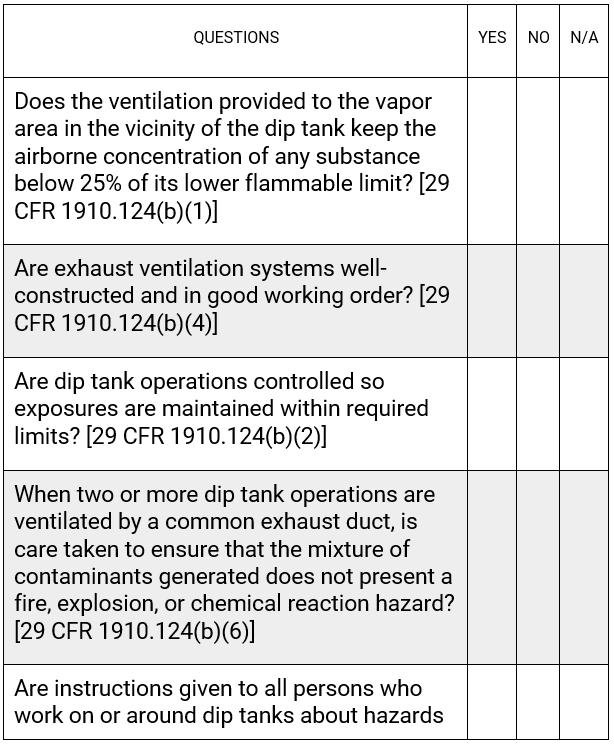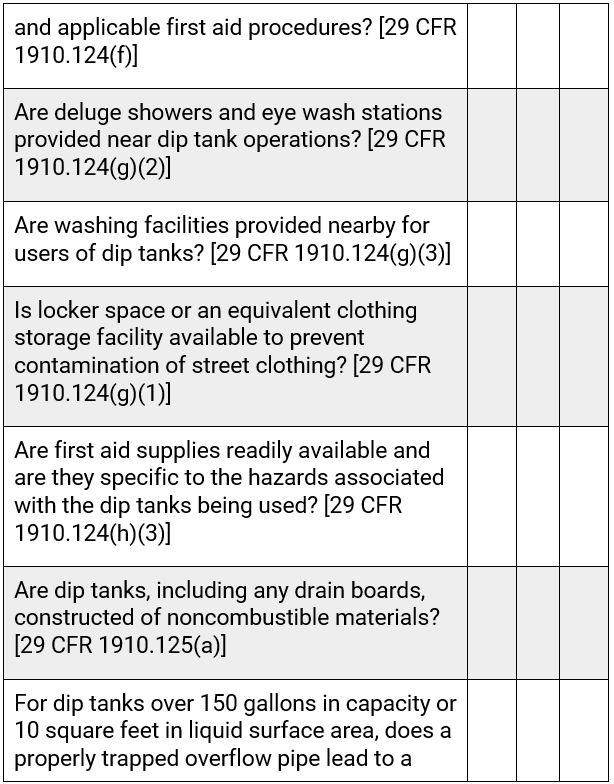Dip Tank Standards – Quick Tips
When coating metals, stripping furniture, repairing vehicles, servicing aircraft or tanning leather, dip tanks may be a necessary part of the process. A dip tank is a container holding a liquid other than water that is used for dipping or coating. An object may be immersed (or partially immersed) in a dip tank or it may be suspended in a vapor coming from the tank. The liquid chemicals used in dip tanks are often dangerous, posing both a safety and health risk. These liquids include flammables such as acetone, corrosives such as cyanide and chromic acids and chronic toxins such as perchloroethylene and methylene chloride.
The Occupational Safety and Health Administration (OSHA) regulations that address the safe use of dip tanks are located in 29 Code of Federal Regulations (CFR) 1910.122 through 1910.126. 29 CFR 1910.122 is the table of contents for sections 1910.123 through 1910.126. It also contains a summary of applicable questions and answers which are used to qualify compliance. Section 123 of the dip tank standard clarifies who is covered and what operations are covered.
1910.123 Dipping and Coating Operations: Coverage and Definitions
(a) Does this rule apply to me? (1) This rule (1910.123 through 1910.126) applies when you use a dip tank containing a liquid other than water. It applies when you use the liquid in the tank or its vapor to:
(a)(1)(i) Clean an object;
(a)(1)(ii) Coat an object;
(a)(1)(iii) Alter the surface of an object; or
(a)(1)(iv) Change the character of an object.
(b) What operations are covered?
Examples of covered operations are paint dipping, electroplating, pickling, quenching, tanning, degreasing, stripping, cleaning, roll coating, flow coating and curtain coating.
(c) What operations are NOT covered?
You are not covered by this rule if your dip-tank operation only uses a molten material (e.g., molten metal, alloy, or salt).
The following checklist applies to dip tanks and any vapor area containing dangerous quantities of flammable vapors addressed in 29 CFR 1910.124 – 126. Although this checklist is not all-inclusive, it may be used as a general hazard-assessment tool.


*download pdf for full checklist
Frequently Asked Questions
Q: What is a flammable liquid?
A: A flammable liquid is any liquid having a flashpoint at or below 199.4°F (93°C). A flashpoint is the temperature at which a liquid gives off enough flammable vapors to form a mixture with air that can be ignited by contact with a hot surface, spark or flame.
Q: What are the differences between a dip tank, wash tank and rinse tank?
A: Dip tanks, wash tanks and rinse tanks are all safe solutions for parts cleaning. Dip tanks and wash tanks are used for cleaning parts where the volume of work does not warrant a larger rinse tank. Dip tank capacities generally range from one-gallon to eight-gallons. Wash tanks are sized exactly like the dip tanks and they include a parts basket to facilitate washing multiple small parts.
Sources
The information contained in this article is intended for general information purposes only and is based on information available as of the initial date of publication. No representation is made that the information or references are complete or remain current. This article is not a substitute for review of current applicable government regulations, industry standards, or other standards specific to your business and/or activities and should not be construed as legal advice or opinion. Readers with specific questions should refer to the applicable standards or consult with an attorney.
Source: Grainger Know How – https://www.grainger.com/know-how